While going electric is all well and good, the biggest barrier to entry into the EV life is price. In fact, according to car megasite Edmunds.com, the average price of a new EV, as of March 2022, is just over $60,000. High-performing electric cars like the Mercedes-Benz EQ are even more expensive.
There is a significant push in the market, through dealer rebates, government tax incentives, and even some states outright paying you a few thousand dollars worth of carbon rebates, for widespread adoption of electric vehicles. Yet, with an average price more expensive than a brand new 2022 Ford Mustang Mach 1 Premium, the second most powerful Mustang you can buy at $58,000, that is a significant jump above the “Affordable” market space.
There are, however, some manufacturers trying to push the electric vehicle down to where the average consumer can realistically look at them beside a hybrid or full gas car as they shop. However, even with the least expensive EV on the US market at the moment at $25,600, it’s still asking a decent amount.
As well, some manufacturers might set their MSRP low, but you do have to remember that dealerships are businesses and can mark up popular models quite a bit, such as what happened this year with the Ford Mustang Mach-E. The 2022 model is no longer available as they have literally sold out of them, with most leaving dealership lots, even after rebates and incentives, for well over $50,000. As such, we are listing the original MSRP of each vehicle, without rebates, incentives, destination charges, or markups, or what is known as the “paper price” of the car.
2023 Chevrolet Bolt Hatchback
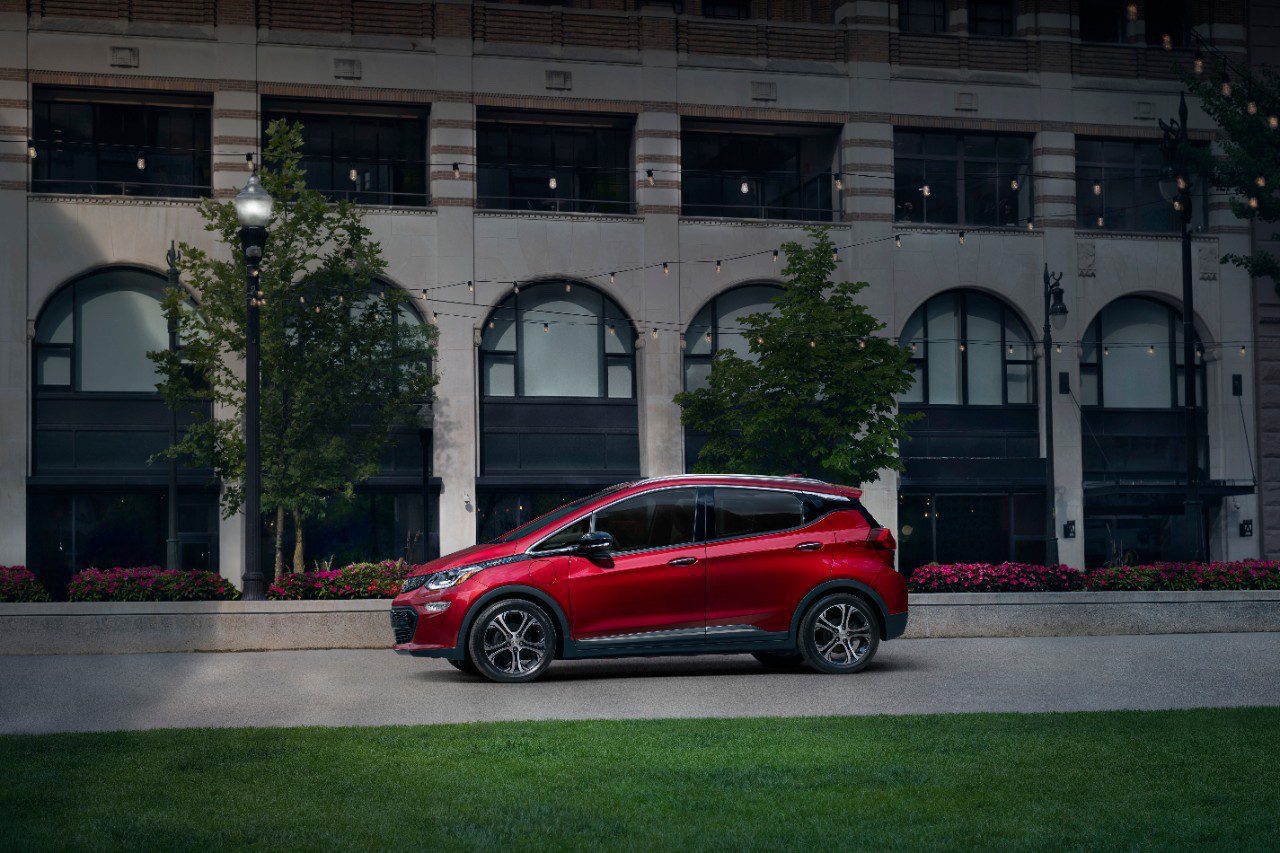
- MSRP: $25,600
- Range (claimed, EPA): 259 miles
- Power (HP): 200
- Torque (lbs-ft): 266
- Battery (kWh): 65
- Onboard Charger: 11.5 kW
The lowest-price EV you can buy on the market, the Chevy Bolt is one of the most complete offerings at a great price. For your money, you get a small five-door hatchback that is understated and, dare we say, “normal” in looks, with very good power for a car this size, an absolute abundance of interior room, a triple level charge port, an on-board charger for plugging into a normal wall socket, and a nigh-unbeatable range figure. On top of that, if you finance or lease a 2022 or 2023 Bolt EV, Chevy will cover the level 2 (240 volt) home charger installation.
As with almost every Chevy, there is an upmarket trim package that, we think, might actually be worth it. For an extra $3,900, which still keeps the price under $30,000, you can get the 2LT package, which includes: leather seats and a leather wrapped steering wheel, 17 inch aluminum wheels, a power adjust driver’s seat, ambient instrument panel lighting, a surround-view camera; an auto-dimming rearview mirror, heated front seats, rear-cross traffic alert and automatic braking, a wireless phone charger, and adaptive cruise control, among other smaller upgrades.
2023 Chevrolet Bolt EUV
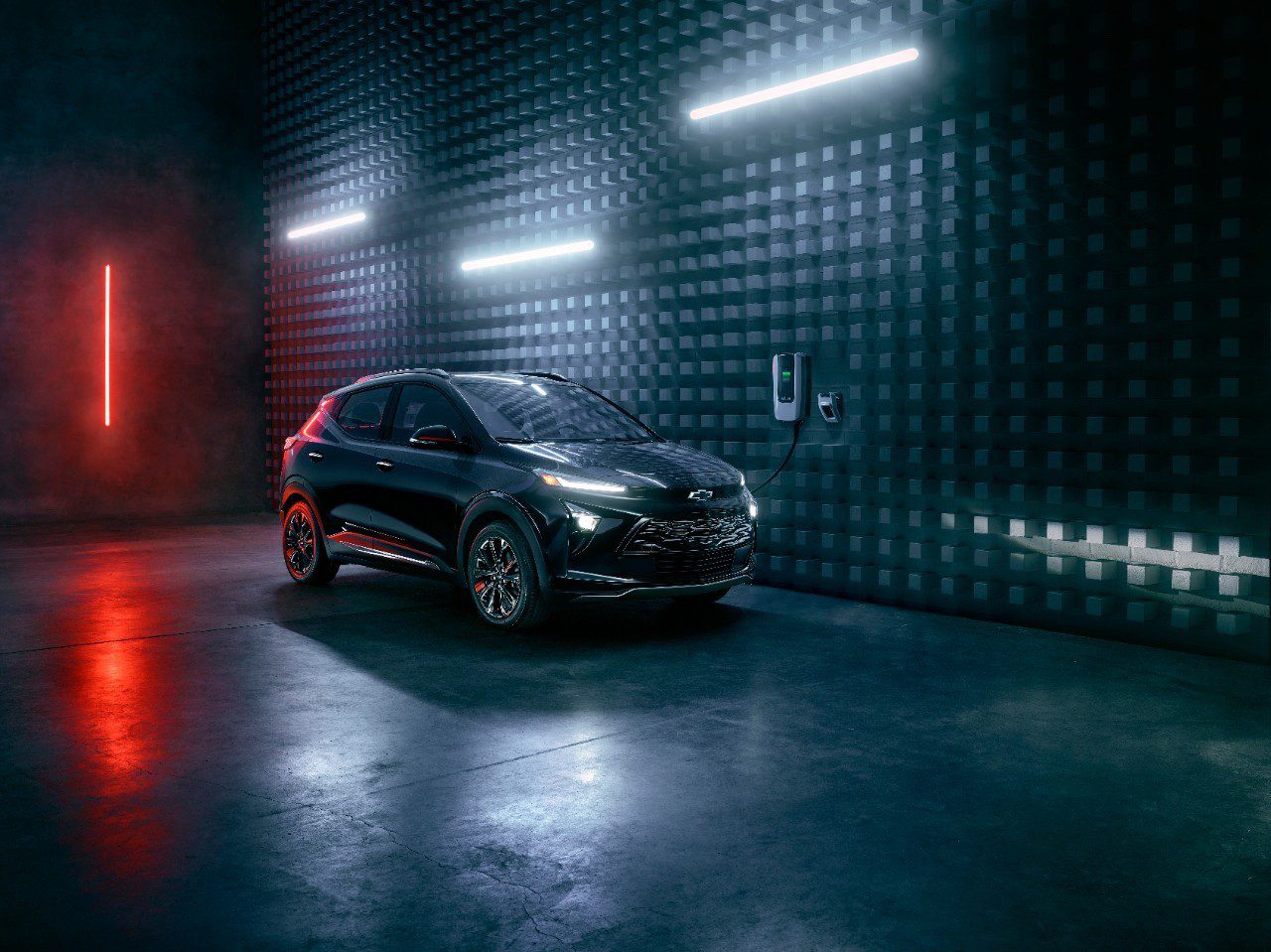
- MSRP: $27,200
- Range (claimed, EPA): 247 miles
- Power (HP): 200
- Torque (lbs-ft): 266
- Battery (kWh): 65
- Onboard Charger: 11.5 kW
The 2023 Chevrolet Bolt EUV is realistically just a bigger version of the hatchback Bolt, but it does come with two feature packages that are not on its little brother. The first of these is the “Sun & Sound” package option for $2,500 that adds a panoramic sunroof and places a 7 speaker Bose premium audio system in the car. The other, far more interesting and valuable package is the “Super Cruise” option for $2,200 that adds level 2 autonomous driving to the car.
Level 2 autonomous driving, for the uninitiated, requires a driver to be aware and at the wheel, but they don’t necessarily have to touch the controls. The car will drive itself on compatible roads, although it does have driver monitoring systems that if you seem distracted or, worse, asleep, it will sound an alarm, and if nothing happens, it will bring the car gently to a stop. The other thing that comes with Super Cruise is that even if you are at the controls, if the computer detects an unavoidable crash about to occur, and it will hit the brakes before you might even register that you are headed for a crash.
2023 Ford F-150 Lightning
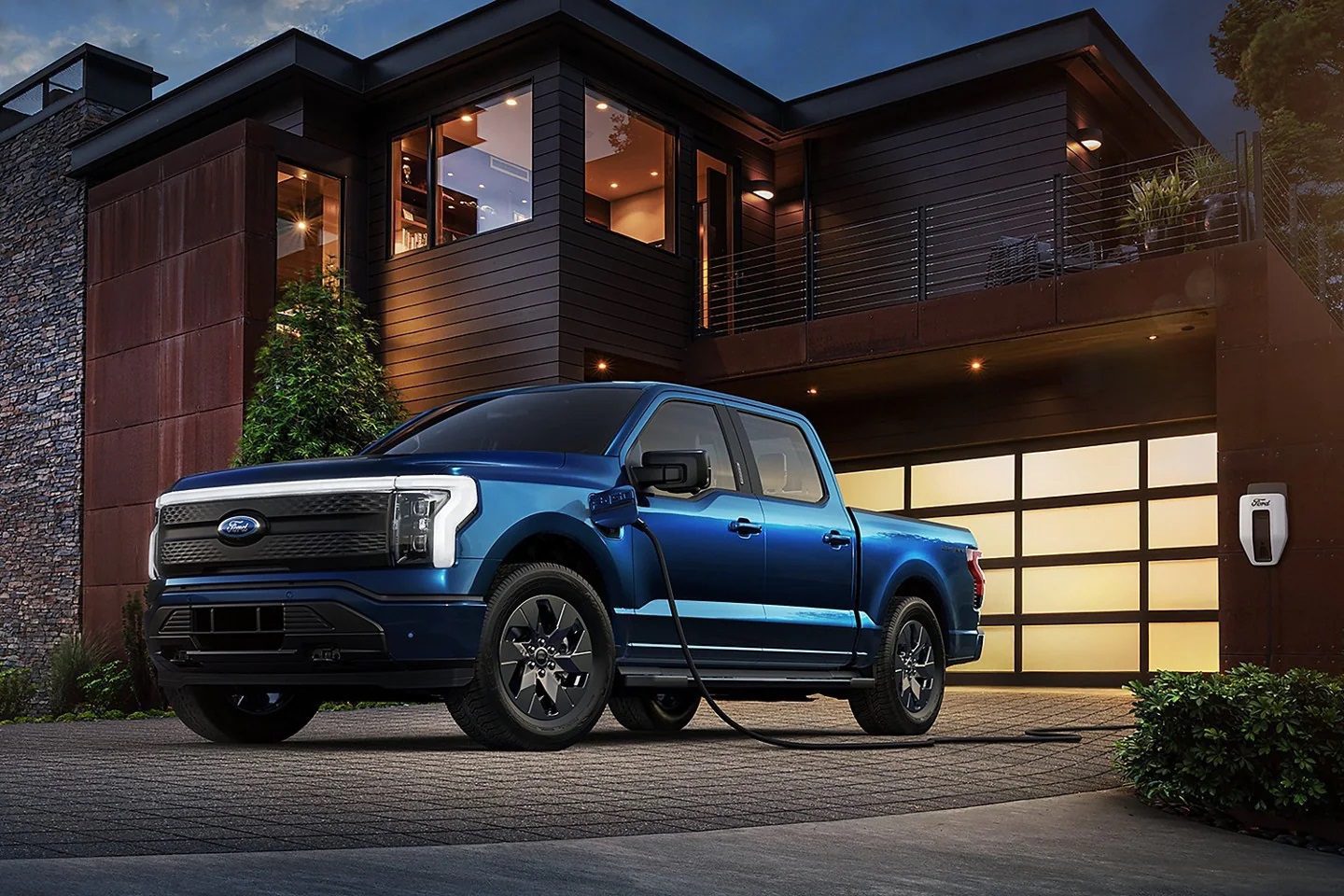
- MSRP: $39,947
- Range (claimed, EPA): 230
- Power (HP): 426
- Torque (lbs-ft): 775
- Battery (kWh): 98 kWh
- Onboard Charger: 11.3 kW
The Ford F-150 Lightning is the second EV from the big blue oval company, and it only makes sense. The first EV, the Mustang Mach-E, banked in on the performance aspect of EVs, while their second, the Lightning, is of the model that has sold more than any other model in the entire Ford range. It is also Ford’s response to the upstart challenger, Rivian, with their R1T model truck, and the base model comes in at just over half the price of one.
This isn’t to say that the Lightning is a slouch, far from it. With the base spec “Pro” model, you get a dual motor, axle-drive, continuously-AWD powertrain that gives the truck a 2,235 lbs payload capacity and a 5,000 towing capacity. The flipside is that the Lightning is quite heavy at 6,200 lbs.
As well, to make the Lightning Pro carry a lot of value for its price, you do get a full suite of expected connectivity through the Sync 4A EV specific infotainment system, Co-Pilot360 2.0, and the latest versions of Ford’s anti-collision, blind-spot-awareness, and adaptive cruise control technology. On top of all that, you get a full 8 year/100,000 mile warranty on all EV core components, including the batteries and motors—one of the best EV warranties on the market.
Note: The 2022 F-150 Lightning is not available to purchase as Ford has filled all available build allocation slots as of May 2022. If you are interested in ordering an F-150 Lightning, you will need to contact your local dealership and get on their waitlist.
2023 Ford Mustang Mach-E
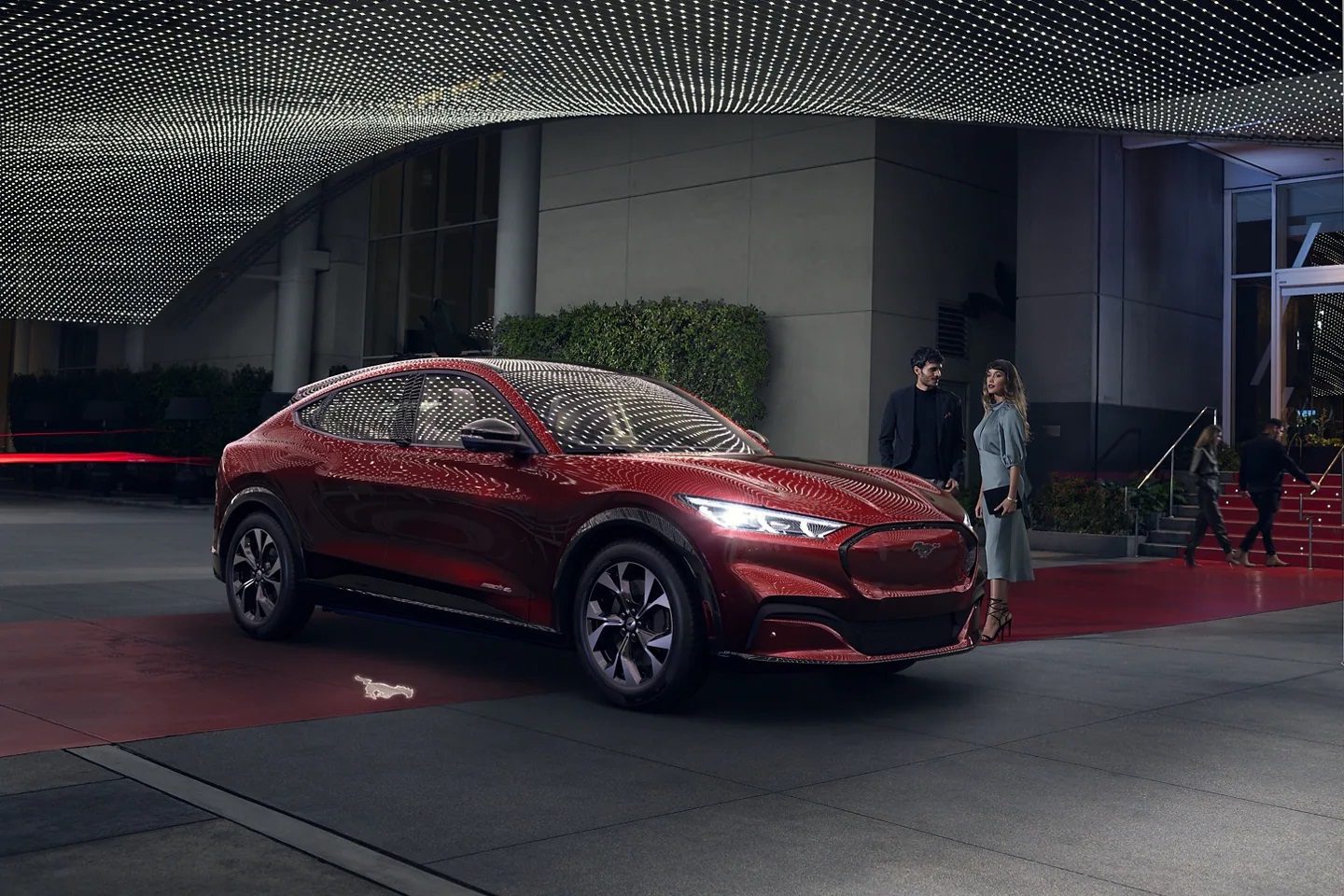
- MSRP: $43,895
- Range (claimed, EPA): 247 miles
- Power (HP): 266
- Torque (lbs-ft): 428
- Battery (kWh): 76 kWh (68 kWh usable)
- Onboard Charger: 11.5 kW
Ford’s first true EV, the Mustang Mach-E, was not what many were expecting. When you throw the word “Mustang” into a discussion about cars, you get the image of a muscle car that sits low down, with a long hood, a fastback tail, and a whole ton of power. The Mach-E fills in a bit of an odd niche, known as EUV (Electric Utility Vehicle), which is a bit bigger than a CUV, but a lot smaller than an SUV, and can often drive circles around both.
The Mustang Mach-E, however, is the performance EV of Ford’s current two-car lineup. The base spec “Select” model, whose numbers are in the little information blurb above, will still get you to 60 MPH from a dead stop in a hint over 5 seconds, and has an electronically governed 124 MPH top speed—not that there is anywhere in the USA where the speed limit is anywhere near that.
Since the Mach-E Select is the entry level for new buyers in the EV market, it comes absolutely packed to the gills with technology. Much like its brother, the F-150 Lightning, it comes standard with an 8 year/100,000 mile EV core components warranty, Co-Pilot360 2.0, and Sync 4A.
With the Select, however, you get the option, for a few thousand more, to add BlueCruise, which is the first implementation of Ford’s Level 2 Autonomous Driving system. It is definitely a performance EV wrapped in an EUV body, but the sharp end of the model line with the GT edition at $62,000 is where it becomes a “muscle EV” with a 3.5 second 0 to 60 (which, unfortunately does not come in under $50,000).
Note: The 2022 Mustang Mach-E is not available to purchase as Ford has filled all available build allocation slots as of May 2022. If you are interested in ordering a Mustang Mach-E, you will need to contact your local dealership and get on their waitlist.
2023 Hyundai Kona
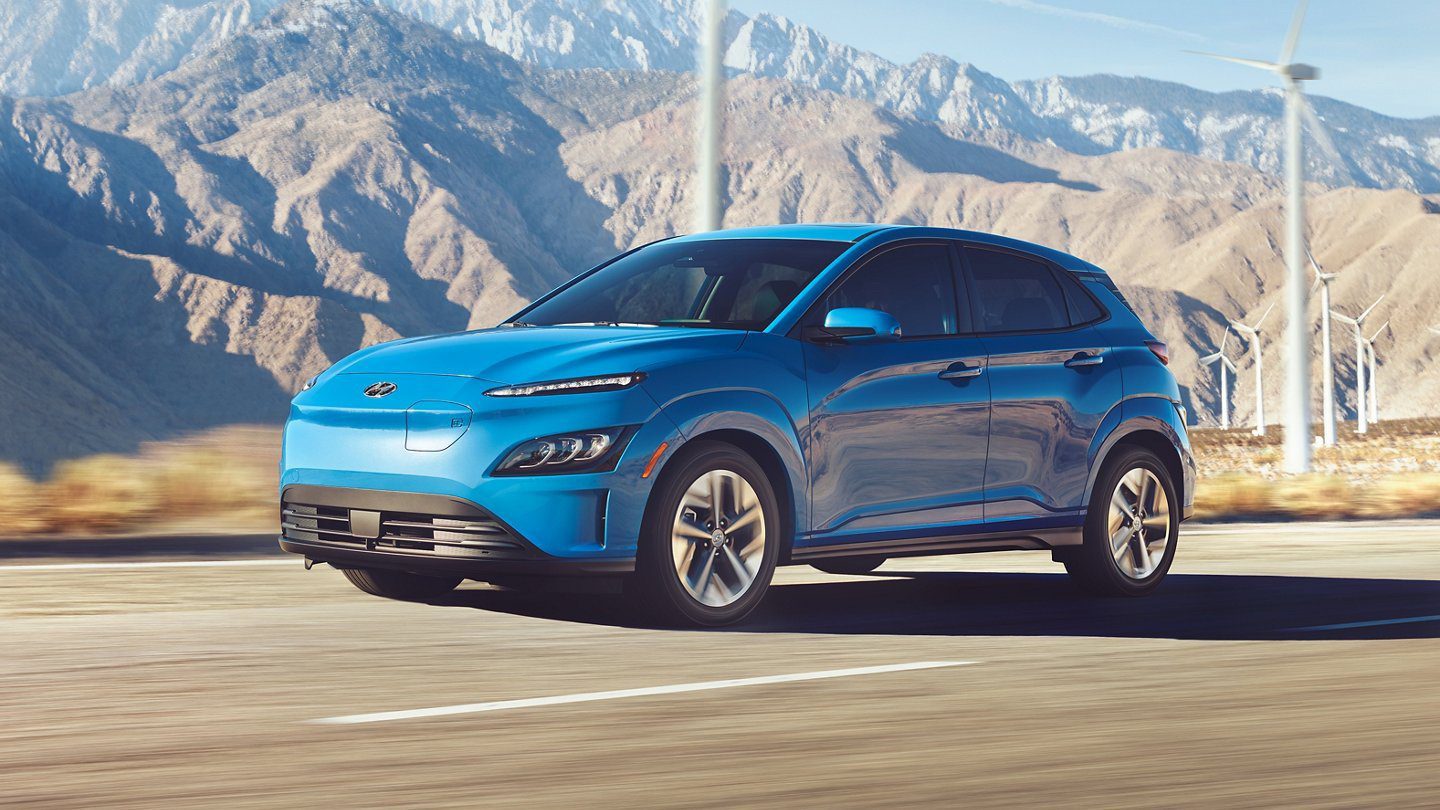
- MSRP: $34,000
- Range (claimed, EPA): 258 miles
- Power (HP): 201
- Torque (lbs-ft): 291
- Battery (kWh): 64 kWh
- Onboard Charger: 7.2 kW
While most manufacturers are focusing on small, efficient sedans or bigger eTrucks and EUVs, Hyundai, as they always seem to do, spotted a perfect gap in the market. It’s classified as an SUV for ease of understanding, but it is more or less a really hopped up five-door hatchback.
However, Hyundai is known for putting a ton of features into their base model cars, and that is absolutely true here as well on the base SEL model. If you splurge the extra $8,500 to go up to the Limited model at just over $42,500, that almost literally has a kitchen sink included with all the features it packs in. It should also be noted that the Kona EV, much like its petrol powered version, is front axle drive only.
Key to all of this is that only one safety feature is optional on the SEL, the rear parking distance sensors. Otherwise, you get regenerative braking ABS, Stability, Traction and Braking Assist control, tire pressure sensors, blind-spot assist, rear cross-traffic collision avoidance, lane keeping assist, lane following assist, a driver attention warning system—the list goes on for about two pages in Hyundai’s brochure, there are that many standard features.
The only things you really get with the Limited are leather seating with heaters, a 10 inch infotainment screen, automatic LED headlights, rain sensing wipers, wireless phone charging, a digital key that you can use on your phone to start up the air conditioning or heater in the Kona before you get to it, and a few more USB outlets.
However, where Hyundai torpedoes everyone else out of the water, save for their sister brand Kia, is with the warranty. 10 years/100,000 EV battery. 5 years/60,000 miles new vehicle. 10 years/100,000 miles full EV powertrain. 7 years/unlimited anti-perforation. Just to sweeten the deal even more, they’ve also thrown in 5 years/unlimited miles of 24/7 roadside assistance and recovery (something many other manufacturers have as a value-add option on their cars), absolutely free.
2023 Hyundai Ioniq 5
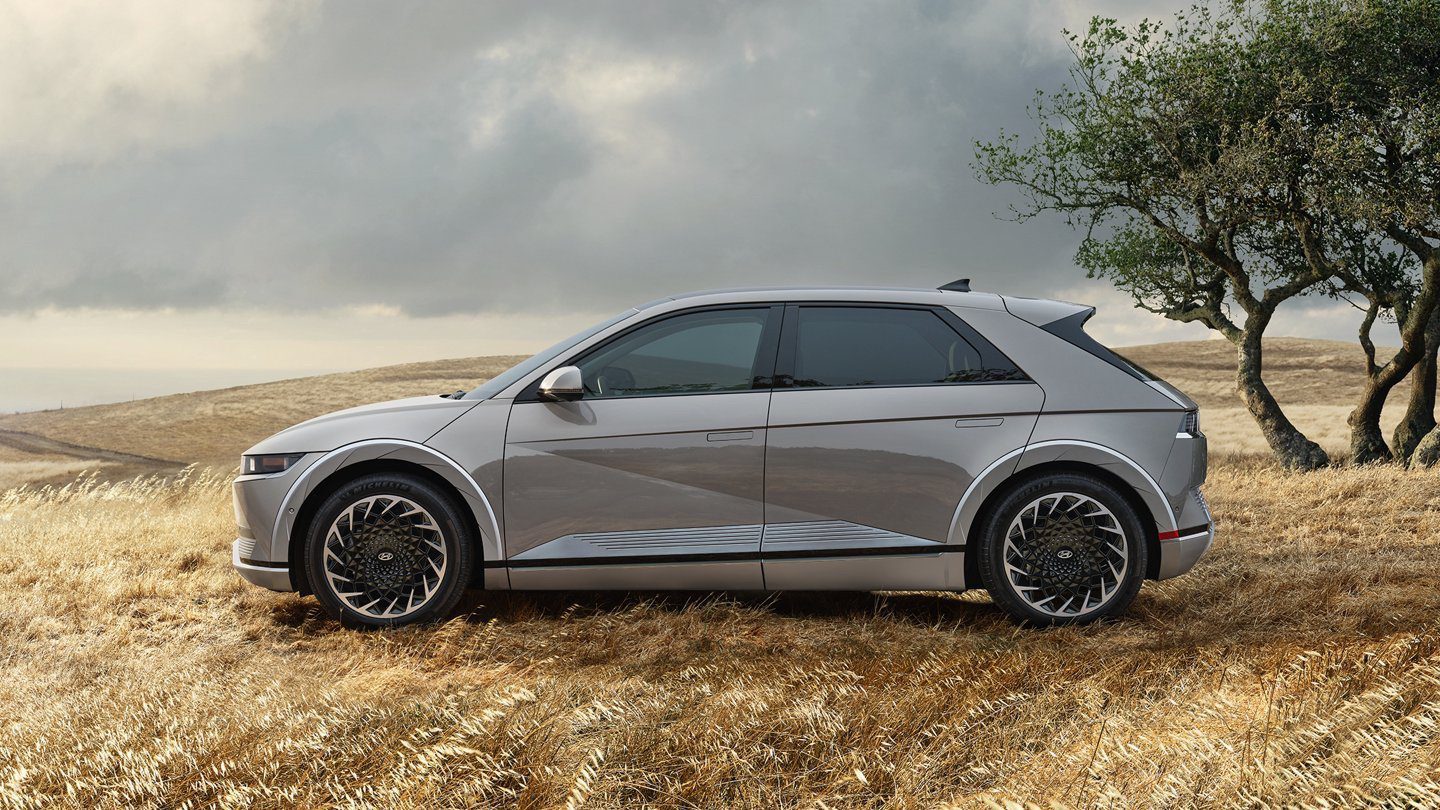
- MSRP: $39.950
- Range (claimed, EPA): 249 (SE standard), 282 (SE, SEL), 303 (SE AWD and SEL in single-motor mode)
- Power (HP): 168 (SE standard), 225 (SE and SEL in single motor mode), 320 (SE and SEL in AWD mode)
- Torque (lbs-ft): 258 lbs-ft (all versions in FWD mode), 446 (SE)
- Battery (kWh): 58 kWh (SE standard), 77.4 kWh (SE AWD, SEL)
- Onboard Charger: 7.2 kW
The Ioniq 5 is Hyundai’s challenger to the big T’s Model 3, and it hits the ground running. There are three trims, SE standard (single motor FWD only) at $39,950, the SE (dual motor AWD) at $44,000, and the SEL (dual motor AWD) at $46,250. Only the top of the range Limited breaks over $50,000—and even then, by just $1,100. So what do you get with the Ioniq 5, which had a small release in 2022 but will have a full release in 2023?
First of all, if you get any of the dual motor versions, you get a very impressive motor control system. Either manually, or letting the system decide, you can have your Ioniq 5 in front-wheel-drive, rear-wheel-drive, or all-wheel-drive. That led to the information blurb above being quite packed, but it also means you can rely on the safety of AWD in normal driving, or use FWD or RWD if you are hypermiling to get those 303 EPA estimated miles.
As well, much like its cousin, the Kona, even the SE standard comes packed to the roofline with features. Key among these is that the Ioniq 5 is the pilot car for Hyundai’s implementation of the CCS Level 3 rapid charge connection, which can handle 350 kW/800 Volts, which will take the battery from 10% to 80% in under 20 minutes.
It also, like the Kona, carries Hyundai’s unbeatable, industry-leading warranty with 10 years/100,000 miles on the EV components, 7 years on rust, 5 years/60,000 miles on each new vehicle, and 5 years of complimentary 24/7 roadside assistance.
The Ioniq 5 was such a surprisingly good vehicle as an answer to Tesla’s Model 3 that it won 3 trophies at the 2022 World Car Awards: Overall World Car of the Year, World Car Design of the Year, and World Car EV of the Year. For a small, 5 door hatchback, that’s a pretty impressive resume!
2023 Kia Niro
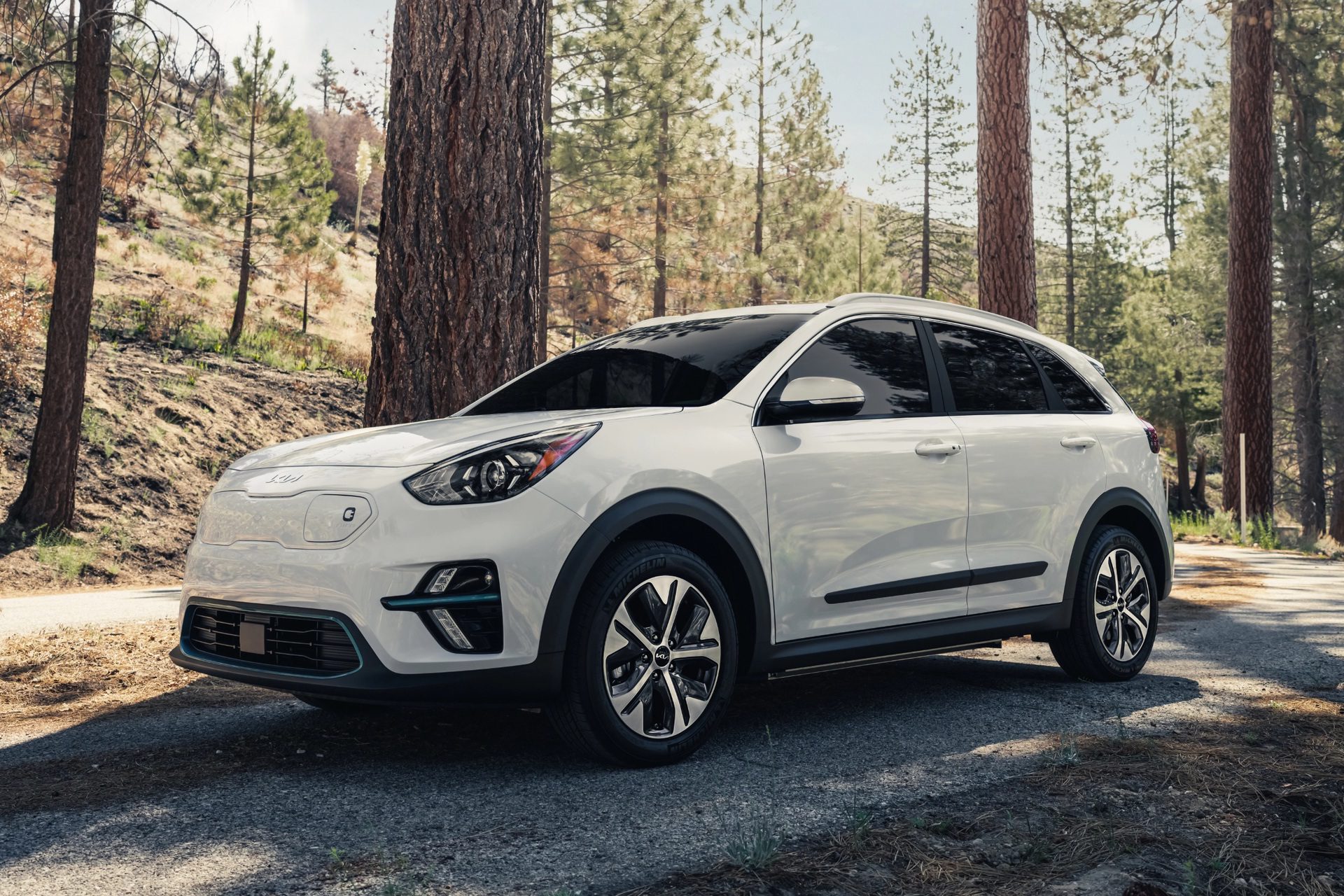
- MSRP: $39,990
- Range (claimed, EPA): 239
- Power (HP): 201
- Torque (lbs-ft): 291
- Battery (kWh): 64 kWh
- Onboard Charger: 7.2 kW
Much like the Hyundai Kona from its sister company, the Kia Niro is an EUV/CUV in name, but it is really a slightly buffed up 5 door hatchback. It does come in, however, slightly more “mainstream,” if that’s the correct term, compared to the Kona or really any of the other EVs. It just simply looks like a well-designed, nicely-engineered car. No sharp angles or futuristic slashes in the body, just… a car.
Since Kia is a sister company to Hyundai, it also follows the trend of giving you so much in the base spec EX model that it is worth far more than its asking price. The standard features list is so large, in fact, that it’s easier to list what’s not included. The EX Premium comes with a sunroof, heated/cooled front seats, SynTex seating surfaces, and a heated steering wheel. That’s it. That’s the difference in specs.
The Niro is no slouch either, as that instant torque of the electric motor will haul the car to 60 in a hair over 6 seconds. Handling is something that Kia does extremely well, and it’s no different here, with many reviews stating how agile and positive the steering feel is. It also boasts a warranty much like Hyundai, with 10 years/100,000 miles for the EV core components, 5 year/60,000 on each new vehicle, 5 year/unlimited roadside assistance, with the only difference being a 5 year/100,000 mile rust warranty instead of the 7 year/unlimited from its sister company.
2023 Kia EV6
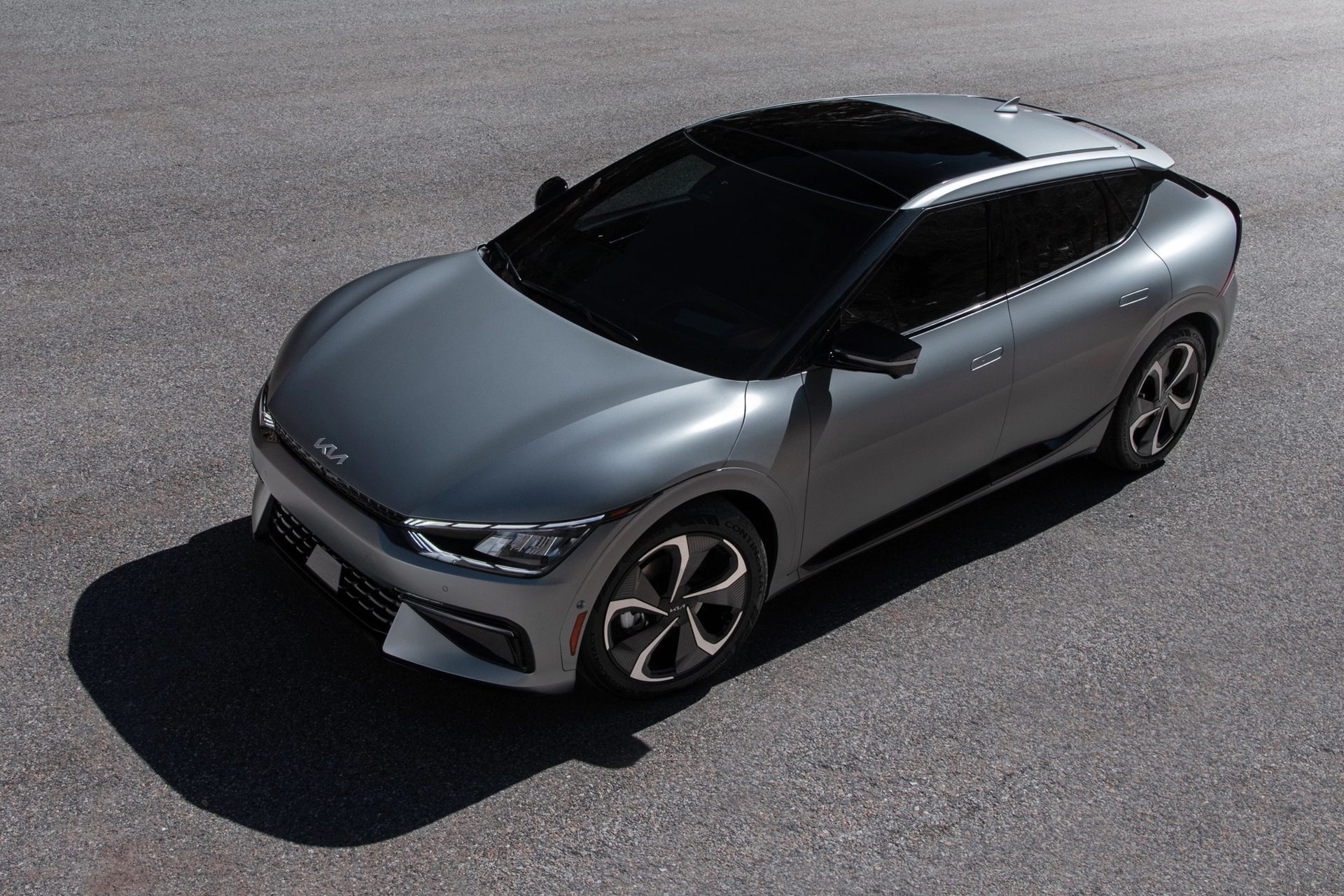
- MSRP: $41,400
- Range (claimed, EPA): 232 (Light), 310 (Wind)
- Power (HP): 167 (Light), 225 (Wind)
- Torque (lbs-ft): 258
- Battery (kWh): 58.0 kWh (Light), 77.4 kWh (Wind)
- Onboard Charger: 7.2 kW
Again, compared to the equivalent from its sister company, the Kia EV6 is the sportier, smaller, hatchback-ier EV being offered. Sharing many of the same driveline components as the Ioniq 5, where the EV6 differs is that in the two trims under $50,000 (the Light and the Wind), it is permanently rear wheel drive. It also has, arguably, one of the best-looking exteriors of any EV in this price bracket. It’s low, flowing, and aggressive, while also being extremely aerodynamically efficient.
Much like its brother from Hyundai, the EV6 is fully DCFC CCS quick-charge ready, although it tops out at 150 kW. The difference between the two trims is that the Light, as implied by its name, is meant more for light duty such as in-city runabout driving and has a 58 kWh battery. The Wind is the inter-city, lower-cost option from Kia, and has a 77.3 kWh battery.
Both also have about every feature that they can have shoehorned in under the skin, with the biggest difference between these trims and the higher up GT trims being that those higher up ones have dual motors and e-AWD, as well as 320 HP.
So what does that really mean? SatNav is included on every trim, with an over-the-air continuously updated charge point locator that shows you how busy that charge point is. You get two massive screens in the cockpit, with a ton of customization and information options. You get the amazing warranty on any trim. You get a well-built, nicely-appointed soft-touch materials cabin that feels a lot more premium than the price you pay for the car.
All of the standard safety features you’d think should be on a car are included with the EV6. Hell, all trim levels get the same amount of cupholders! Kia (and Hyundai) really do have the “amazing value for the price” thing down to an art and a science.
2022 Mazda MX-30 (Pilot Program in California Only)
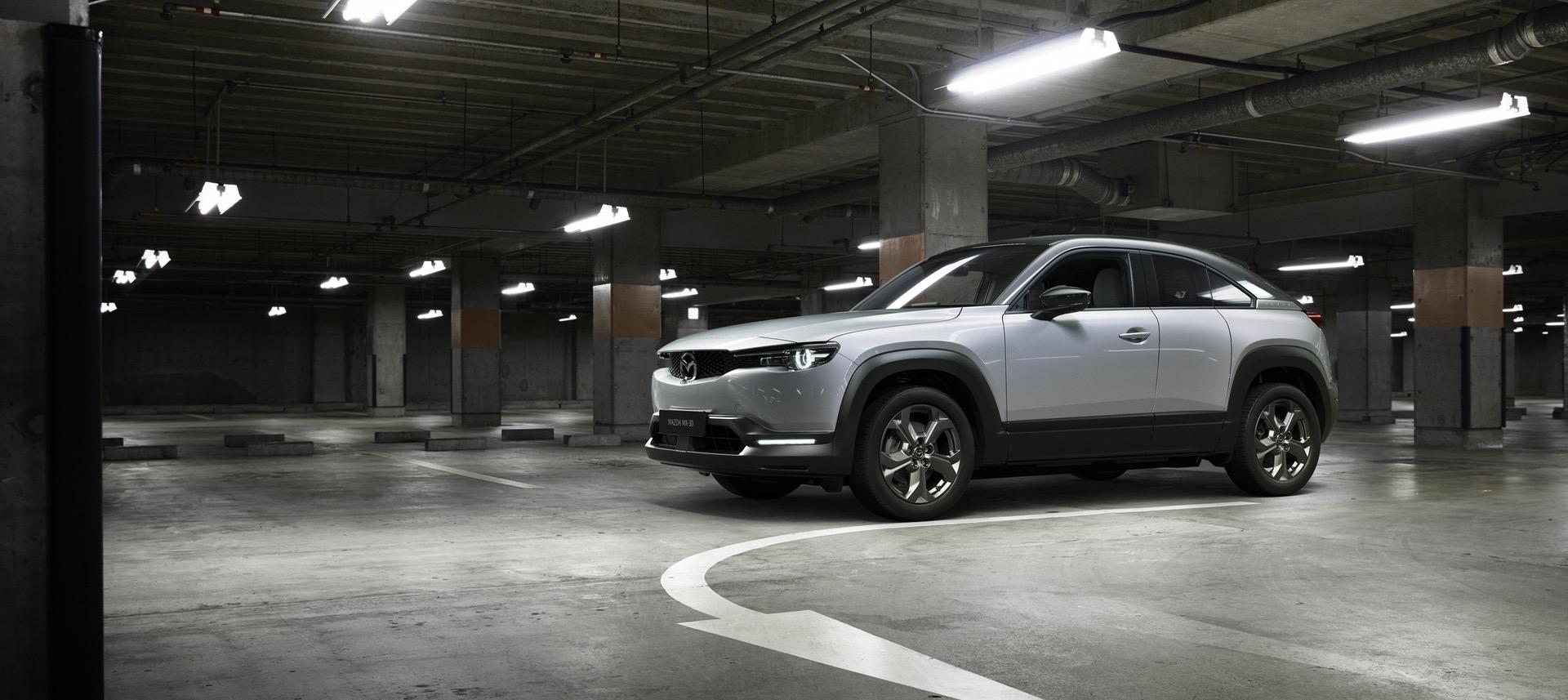
- MSRP: $33,470
- Range (claimed, EPA): 100 miles
- Power (HP): 143
- Torque (lbs-ft): 200
- Battery (kWh): 35.5 kWh
- Onboard Charger: 6.6 kW
The 2022 MX-30 is a very interesting, and also very niche, vehicle. You might look at the specs in the information blurb above and wonder why it has such a tiny battery and only 100 miles of estimated range.
However, if you live in a really packed city like Los Angeles or New York, you realistically only drive about 30 miles per day, maybe 50 miles if you have a longer commute. This is what the MX-30 was built for, and why its pilot program is California based—as you have big cities like San Francisco, Los Angeles, and San Diego all within the state.
The MX-30’s battery is small because it is also fast-charge optimized, both for the built-in 6.6 kW Level 1 charger that can take it from 20% to 80% overnight, but if you suddenly connect it to a 240V Level 2 home charger, it takes all of 3.5 hours to charge from 10% to 100%. Connect it to a Level 3 charging station, and how does half an hour to completely charge the battery sound?
Since you’re also only really driving those 30 to 50 miles per day, cut that time by one-third or half—so realistically, by the time you plug in your MX-30, head into the coffee shop, wait in line, buy your coffee, and get back out to your car, it’s done charging.
It’s also small, and is FWD only, to keep the biggest drawback of an EV (weight) as low as possible. Drive a lightweight Mazda like an MX-5 or a Mazda 3, and instantly you’ll understand why a lightweight vehicle is much more fun to drive, especially from a company that is as OCD about vehicle dynamics and handling like Mazda.
This isn’t to say that the MX-30 doesn’t have practicality as well, as it has generous cargo capacity, 60/40 folding rear seats, and a small frunk under the hood for toolkits or a day bag.
Mazda themselves state that the whole concept came from their philosophy of human-centered technology, and the symbiotic relationship between man and machine. As an example, they point out that very few people will use their smartphone until the battery is down to 15% or even 10%, instead plugging it in to charge when the battery is reading 30%.
In that sense, the MX-30 is the same, in that you won’t drive it until it’s down to 20% or 10%. Instead, they’re expecting owners to either charge it overnight, or “top it up” at a charge station if they have 10 to 15 minutes to spare. So far, it’s been quite a successful experiment, as of June 2022 (the most recent sales stats available), 316 MX-30s have been sold, with about half of those in Los Angeles.
2023 Mini Cooper SE
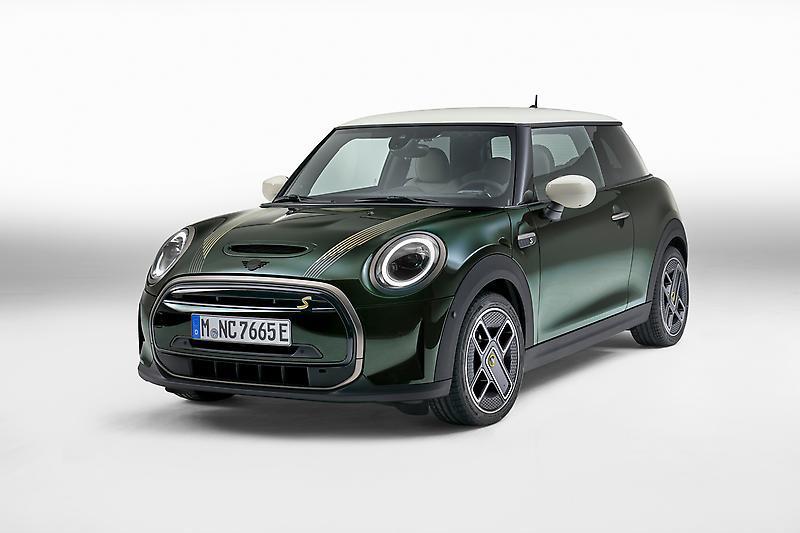
- MSRP: $34,225
- Range (claimed, EPA): 110 miles
- Power (HP): 181
- Torque (lbs-ft): 199
- Battery (kWh): 32.6 kWh
- Onboard Charger: 2.3 kW
The Mini Cooper SE is a very interesting counter-thought in the world of EVs. Most manufacturers are aiming to make their EVs have longer ranges, more technology, and more bells and whistles. However, from BMW, who own the Mini brand, their philosophy is driver first. So, instead of trying to make the SE a hypermiling champion, they focused on the one thing that a lot of EVs miss out on: fun.
The design goal from the outset was to make the Cooper SE as close as possible to their best selling model, the Cooper S. They’ve done a very good job, with the S having 8 more HP, 7 more lbs-ft of torque, and the SE weighing in only 300 lbs more overall, and only increasing about half an inch in length to fit the battery.
The SE also only costs $2,000 more than the S, and is just as much of a hoot to drive. It also has nearly the same 0 to 60 time in the mid 6 second range, and has the exact same amount of cargo room, making it just as practical as the Cooper S.
By keeping the weight low, the power at the front wheels, and not messing about with the stellar dynamics and suspension geometry of the Mini it’s based off of, the Cooper SE will absolutely devour corners, scrabble hungrily down the freeway, and give just as much feel and feedback as its gas-powered variant.
Also, the SE is Level 3 fast charge compatible, and can go from 10% to 80% on the battery with a few ticks over 30 minutes. If your only goal in having an EV is to be grinning ear to ear like a madman after driving it in a spirited manner and then charging it overnight, BMW (through Mini) has you covered.
2022 Nissan Leaf
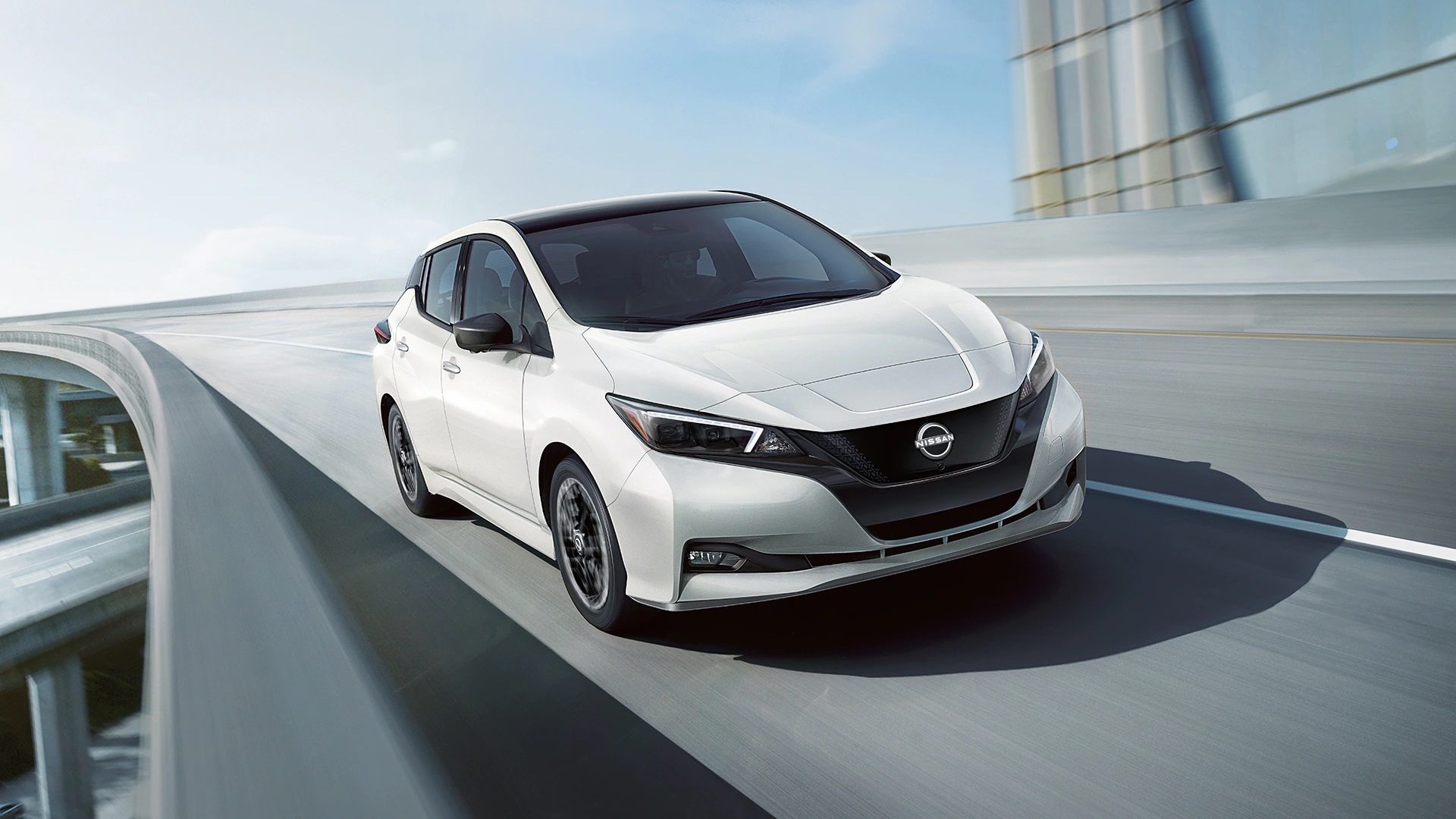
- MSRP: $27,800
- Range (claimed, EPA): 149 miles (S), 212 miles (SV Plus)
- Power (HP): 147 (S), 214 (SV Plus)
- Torque (lbs-ft): 236 (S), 250 (SV Plus)
- Battery (kWh): 40 kWh (S), 60 kWh (SV Plus)
- Onboard Charger: 6.6 kW
The Nissan Leaf was one of the first EVs to come out from a major manufacturer during the dawning of the electrification age, having its debut in 2010. It has sold well, with over 500,000 around the world as of 2021, yet Nissan is hinting that Leaf production will cease after the 2023 model year. In the same breath, they announced the plan to have 15 full EVs in all segments of the market by 2030.
The Leaf doesn’t really stand out from the crowd. It doesn’t have the biggest cargo space, the fastest acceleration, the most dynamic handling, or the fastest (or slowest) charge rate. Nissan, for their part, are also perfectly fine with that. More often than not, you’ll see hundreds of Nissans on your commute or on the interstate, and yet there is nothing about them that shouts out, grabs attention, or gets any other comment other than “hmm, nice car.”
The Leaf, in all honesty, has been surpassed by almost every other model on this list, and with production winding down and its days numbered, it is a great “cheap and cheerful” EV—since to clear off the dealer lots for the next wave of EVs, some clearance and inventory sales are almost guaranteed. For what it’s worth, the Leaf, between 2014 and 2018, had the lowest driver death rate of any car, so if anything, its safety and driver protection features work very well.
2022 Volkswagen ID.4 Pro
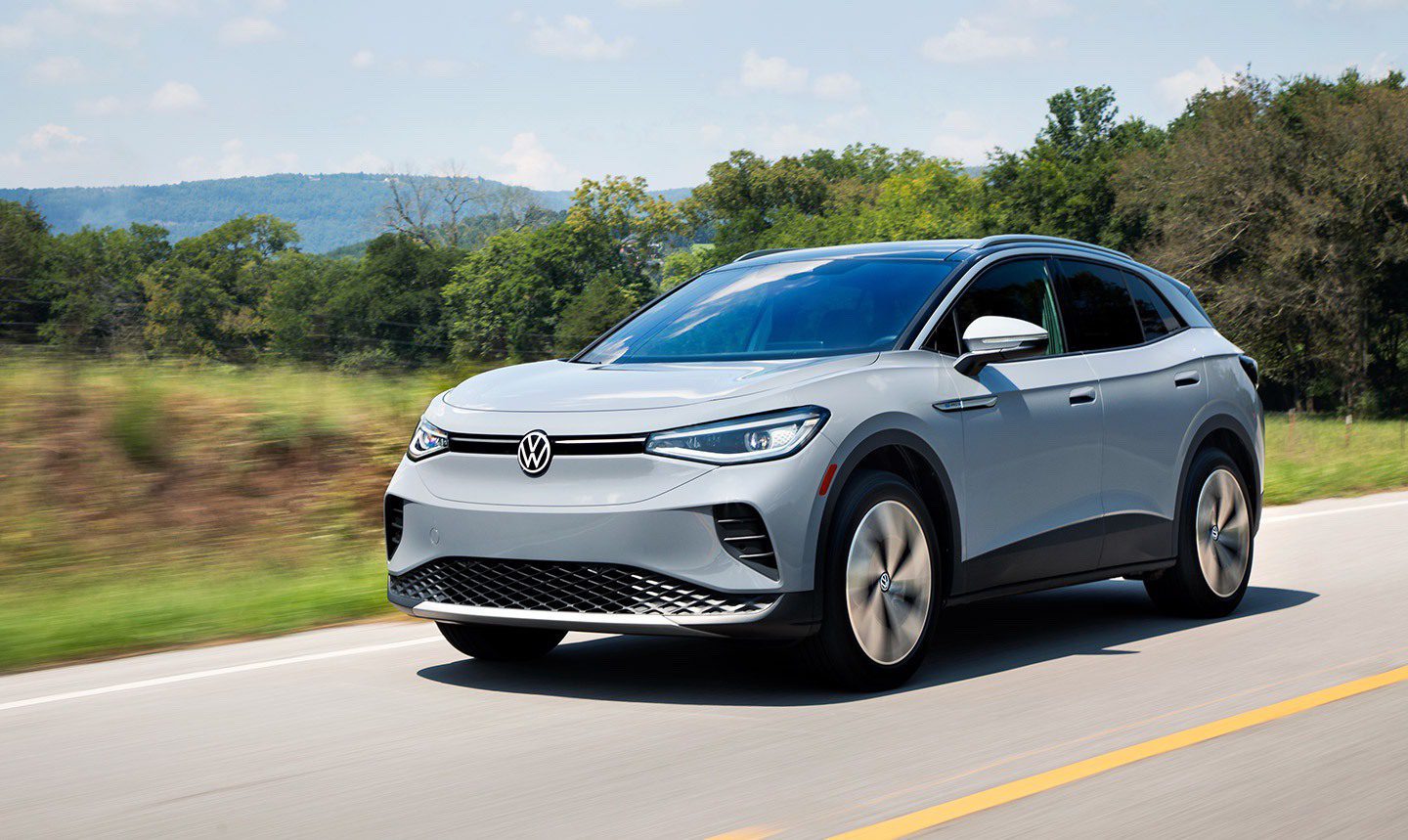
- MSRP: $41,230
- Range (claimed, EPA): 275 miles
- Power (HP): 201
- Torque (lbs-ft): 229
- Battery (kWh): 77 kWh
- Onboard Charger: 11 kW
The VW ID.4 platform is one of those global-scale plans that actually seems to be working, as almost every brand under the VW Group name, including Audi and Porsche, are headed towards 80% or greater EVs in their model ranges by 2030. Designed to fit into the CUV space, the ID.4 Pro, Pro S, and Pro S Gradient may not be setting the world on fire in terms of looks or personality, but they are the first real glimpse at the electric future of the brand.
What you get with the ID.4 Pro is very typically German, meaning that it is one of the best-put-together cars on this list, with superb build quality and some pretty ingenious engineering and design choices. While an AWD model is coming, the ID.4 GTX, the Pro, Pro S, and Pro S Gradient are what you can walk into a dealership and buy right now. All three of those trims have a single motor on the rear axle with 201 HP, and a 0 to 6 time of about 8 seconds. It’s not going to set any speed records, but that isn’t the aim of the car.
Where the ID.4 Pro excels is in its cargo space. That ingenious German engineering and design means that the cabin feels extremely spacious, with a good 30 cubic feet of trunk space without the rear 60/40 seats folded down. If they’re down, expect to be able to carry up to 65 cubic feet of cargo.
This is the EV that Volkswagen wants you to choose if you want to go on a weekend camping trip or a day out in the canyons or mountains for hiking. It is very efficient, not using as much power as possible for blistering acceleration, and because of that it has one of the highest range figures in this list. As their name would imply, Volkswagen wants this to be the first EV “People’s Car.”












More Stories
Verida Transportation: 5 Reasons Why You Should Choose This NEMT Provider
International Trip in Your Ford Fortuner
Verstappen gana en Miami seguido por el Checo Perez y Alonso